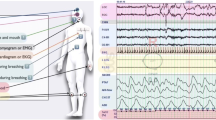Abstract
This study aimed to evaluate the effectiveness of elevated posture in the management of obstructive sleep apnea (OSA). Fourteen subjects presenting with mild-moderate OSA, (apnea-hypopnea index [AHI] 10 to 60/h), were included in a randomized crossover investigation. A shoulder-head elevation pillow (SHEP) was compared with nasal continuous positive airway pressure (nCPAP) therapy. Treatment success was defined as AHI ≤ 10/h and partial success as AHI > 10 < 16/h. Four subjects achieved treatment success with the SHEP and three achieved partial success. The remaining seven subjects were treatment failures. In contrast, success was achieved with nCPAP in 12 subjects. One subject achieved partial success and one was a treatment failure. With the SHEP, the mean AHI decreased from 27 ± 12/h to 21 ± 17/h. With nCPAP, the mean AHI was 5 ± 3/h; (p= 0.008 for the difference between treatments). Although somewhat variable, these data provide evidence that elevated posture during sleep is helpful in the management of OSA in some individuals. Results support the use of elevated posture as second-line therapy in the management of OSA. However, no relationships could be identified between baseline data, including the identification of positional OSA, and objective outcomes that might predict patients who are likely to benefit from treatment in an elevated position.
Similar content being viewed by others
References
Haponik EF, Smith PL, Bohlman ME et al. Computerized tomography in obstructive sleep apnea. Correlation of airway size with physiology during sleep and wakefulness. Am Rev Respir Dis 1983;127:221–226
Suratt PM, Dee P, Atkinson RL, Armstrong P, Wilhoit SC. Fluoroscopic and computed tomographic features of the pharyngeal airway in obstructive sleep apnea. Am Rev Respir Dis 1983;127:487–492
Anch AM, Remmers JE, Bunce HD 3rd. Supraglottic airway resistance in normal subjects and patients with occlusive sleep apnea. J Appl Physiol 1982;53:1158–1163
Remmers JE, deGroot WJ, Sauerland EK, Anch AM. Pathogenesis of upper airway occlusion during sleep. J Appl Physiol 1978;44:931–938
Sforza E, Bacon W, Weiss T et al. Upper airway collapsibility and cephalometric variables in patients with obstructive sleep apnea. Am J Respir Crit Care Med 2000;161:347–352
Brown IB, McClean PA, Boucher R, Zamel N, Hoffstein V. Changes in pharyngeal cross-sectional area with posture and application of continuous positive airway pressure in patients with obstructive sleep apnea. Am Rev Respir Dis 1987;136:628–632
Yildirim N, Fitzpatrick MF, Whyte KF et al. The effect of posture on upper airway dimensions in normal subjects and in patients with the sleep apnea/hypopnea syndrome. Am Rev Respir Dis 1991;144:845–847
Jan MA, Marshall I, Douglas NJ. Effect of posture on upper airway dimensions in normal human. Am J Respir Crit Care Med 1994;149:145–148
Martin SE, Marshall I, Douglas NJ. The effect of posture on airway caliber with the sleep-apnea/hypopnea syndrome. Am J Respir Crit Care Med 1995;152:721–724
Battagel JM, Johal A, Smith AM, Kotecha B. Postural variation in oropharyngeal dimensions in subjects with sleep disordered breathing: a cephalometric study. Eur J Orthod 2002;24:263–276
Tsuiki S, Almeida FR, Bhalla PS, Lowe AA, Fleetham JA. Supine-dependent changes in upper airway size in awake obstructive sleep apnea patients. Sleep Breath 2003;7:43–50
McEvoy RD, Sharp DJ, Thornton AT. The effects of posture on obstructive sleep apnea. Am Rev Respir Dis 1986;133:662–666
Neill AM, Angus SM, Sajkov D, McEvoy RD. Effects of sleep posture on upper airway stability in patients with obstructive sleep apnea. Am J Respir Crit Care Med 1997;155:199–204
Kribbs NB, Pack AI, Kline LR et al. Objective measurement of patterns of nasal CPAP use by patients with obstructive sleep apnea. Am Rev Respir Dis 1993;147:887–895
American Sleep Disorders Association. Practice parameters for the use of portable recording in the assessment of obstructive sleep apnea. Standards of Practice Committee of the American Sleep Disorders Association. Sleep 1994;17:372–377
Dingli K, Coleman EL, Vennelle M et al. Evaluation of a portable device for diagnosing the sleep apnoea/hypopnoea syndrome. Eur Respir J 2003;21:253–259
American Academy of Sleep Medicine. Sleep-related breathing disorders in adults: recommendations for syndrome definition and measurement techniques in clinical research. The Report of an American Academy of Sleep Medicine Task Force. Sleep 1999;22:667–668
Cartwright RD. Effect of sleep position on sleep apnea severity. Sleep 1984;7:110–114
Johns MW. A new method for measuring daytime sleepiness: the Epworth sleepiness scale. Sleep 1991;14:540–545
Weaver TE, Laizner AM, Evans LK et al. An instrument to measure functional status outcomes for disorders of excessive sleepiness. Sleep 1997;20:835–843
Ware JE Jr, Sherbourne CD. The MOS 36-item short-form health survey (SF-36). I. Conceptual framework and item selection. Med Care 1992;30:473–483
Engleman HM, Kingshott RN, Wraith PK, Mackay TW, Deary IJ, Douglas NJ. Randomized placebo-controlled crossover trial of continuous positive airway pressure for mild sleep Apnea/Hypopnea syndrome. Am J Respir Crit Care Med 1999;159:461–467
Skinner MA, Kingshott RN, Jones DR, Taylor DR. Lack of efficacy for a cervicomandibular support collar in the management of obstructive sleep apnea. Chest 2004;125:118–126
Cheshire K, Engleman H, Deary I, Shapiro C, Douglas NJ. Factors impairing daytime performance in patients with sleep apnea/hypopnea syndrome. Arch Intern Med 1992;152:538–541
Kingshott RN, Engleman HM, Deary IJ, Douglas NJ. Does arousal frequency predict daytime function?. Eur Respir J 1998;12:1264–1270
Author information
Authors and Affiliations
Corresponding author
Rights and permissions
About this article
Cite this article
Skinner, M.A., Kingshott, R.N., Jones, D.R. et al. Elevated Posture for the Management of Obstructive Sleep Apnea. Sleep Breath 8, 193–200 (2004). https://doi.org/10.1007/s11325-004-0193-1
Issue Date:
DOI: https://doi.org/10.1007/s11325-004-0193-1




